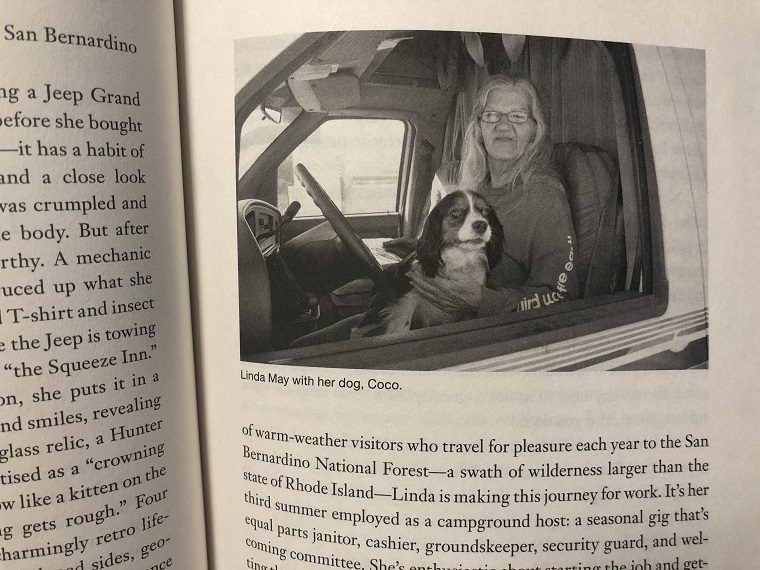Book Review: “Nomadland” by Jessica Bruder
![]()
A retired couple purchases a used RV and heads for the open road. Wandering from place to place, visiting America’s natural wonders, and meeting new people along the way, they decide to opt out of monthly mortgage payments and make their itinerant lifestyle a permanent one.
This may sound like the ultimate dream retirement, but instead, it’s reality for a growing number of couples and individuals. There’s a catch, though: Most people adopt this lifestyle out of economic desperation, and they aren’t traveling for recreation — their vehicles are their only homes, and they’re bound for the latest in a series of low-paid temporary jobs that often require hours of painful physical labor.
In Nomadland: Surviving America in the Twenty-First Century, award-winning journalist Jessica Bruder provides an inspiring yet heartbreaking look at this subculture of transient workers, following their stories as they trek across the United States in search of a paycheck — or sometimes, just survival.
Nomadland: Surviving America in the Twenty-First Century
by Jessica Bruder
Product Details: Hardcover, 320 pages, 6.5” x 9.6”
Retail Price: $26.95 USA
Publication Date: September 19, 2017
ISBN: 978-0-393-24931-6
Publisher: W.W. Norton & Company
Previously Loved: 4 excellent used car options to consider
Nomadland: Book Summary
The pages of Nomadland teem with people who have been relentlessly beaten down by the Great Recession, globalization, and other economic woes. Some of them have lost their houses to foreclosure, while others have done the math and realized that living out of an old van, trailer, or RV and driving from job to job is cheaper than paying the ever-increasing monthly rent.
Nomadland traces the adventures and struggles of these modern-day nomads as they drive from job to job, congregate with like-minded travelers in the desert, and adapt to the dangers and disadvantages of life on the road. Bruder’s narrative puts the closest focus on Linda May, a tough, resourceful grandmother who hits the road after a life of tough economic breaks — but still harbors hopes of building her own sustainable home in the desert.
Readers will also meet Charlene Swankie, aka “Swankie Wheels,” who moves into a van during a period of illness and financial struggle, turns her health around, and ends up paddling all 50 states in her kayak. There’s also the influential and charismatic Bob Wells, who hits the road after a divorce wipes out his finances. As Wells learns more about life on the road, he begins sharing what he knew with others, gradually becoming an influential blogger and evangelizer for the nomadic lifestyle.
Many of these people, who often refer to themselves as “workampers,” rely on seasonal labor to get by. One of their biggest sources of income is Amazon, which — especially during the holiday shopping rush — needs temporary laborers to staff its massive warehouses around the country. In fact, Amazon even runs a CamperForce recruiting program to fill these positions, which involve hours of grueling labor. Other major draws for workampers include campground hosting and seasonal agricultural work.
This life isn’t an easy one. Most of the available jobs require backbreaking effort, and they usually don’t come with security, high wages, or benefits. Aside from the work, just finding a place to park a van or an RV overnight can be a major hassle. Some places, such as Walmart parking lots, are often friendly to overnight parking, but elsewhere, many workampers sleep lightly in fear of a police officer’s knock.
Even with the difficulties of the workamper life, this subculture also provides a deep sense of community. Every summer, nomads flock by the hundreds of thousands to the “Gathering Place” of Quartzsite, Arizona. Here, they relax, peddle wares, socialize with each other, and form close-knit desert camps, turning the small, sleepy town into a bizarrely bustling metropolis. Many also show up to the annual Rubber Tramp Rendezvous, a gathering organized by Bob Wells to help workampers connect and offer newbies an opportunity to learn and take classes from more experienced nomads.
Finance FAQs: What you need to know before investing in your next vehicle
Nomadland: Book Review
The most impressive aspect of Nomadland is Jessica Bruder’s exhaustive reporting. The workamping subculture can’t be easily understood from the outside, so Bruder immersed herself in it over several years. She rode with workampers and got to know them, attended their annual meetups, briefly worked at an Amazon warehouse and took part in a sugar beet harvest, and even drove around the country living in her own van (which she dubbed “Halen”). It would have been easy to sensationalize and skim the surface of this story, but Bruder’s approach aims for insight and depth — and succeeds.
Bruder’s writing pairs this insight with affection and sympathy. It would have been easy for her to view workampers with condescension or pity, but instead, she treats them with the humanity, respect, and admiration they deserve. It’s a real joy to read about the creativity and resourcefulness of unique individuals like Linda May and Bob Wells.
At the same time, although Bruder communicates the hopefulness and resilience of the people she writes about, she doesn’t flinch from the implications of the lifestyle they’ve chosen or been forced into. What happens as her subjects age and are no longer able to care for themselves? How could our society let this happen to people? Why should the workampers struggle to survive while the rich continue to get richer off their labor? Bruder doesn’t necessarily have all the answers, but in an age of increasing inequality and crumbling institutions, she’s asking the right questions.
Nomadland is available through the the publisher’s website, Amazon, and other retailers.
A longtime editor/writer and recently transplanted Hoosier, Caleb Cook lives in Xenia, Ohio. His favorite activities are reading and listening to music, although he occasionally emerges from the heap of books and vinyl records in his basement to stand blinking in the sunlight. Once fully acclimated to the outside world again, he can be observed hanging out with his wife, attempting a new recipe in the kitchen, attending movies, walking the dog, or wandering into a local brewery to inquire about what’s on tap. See more articles by Caleb.




